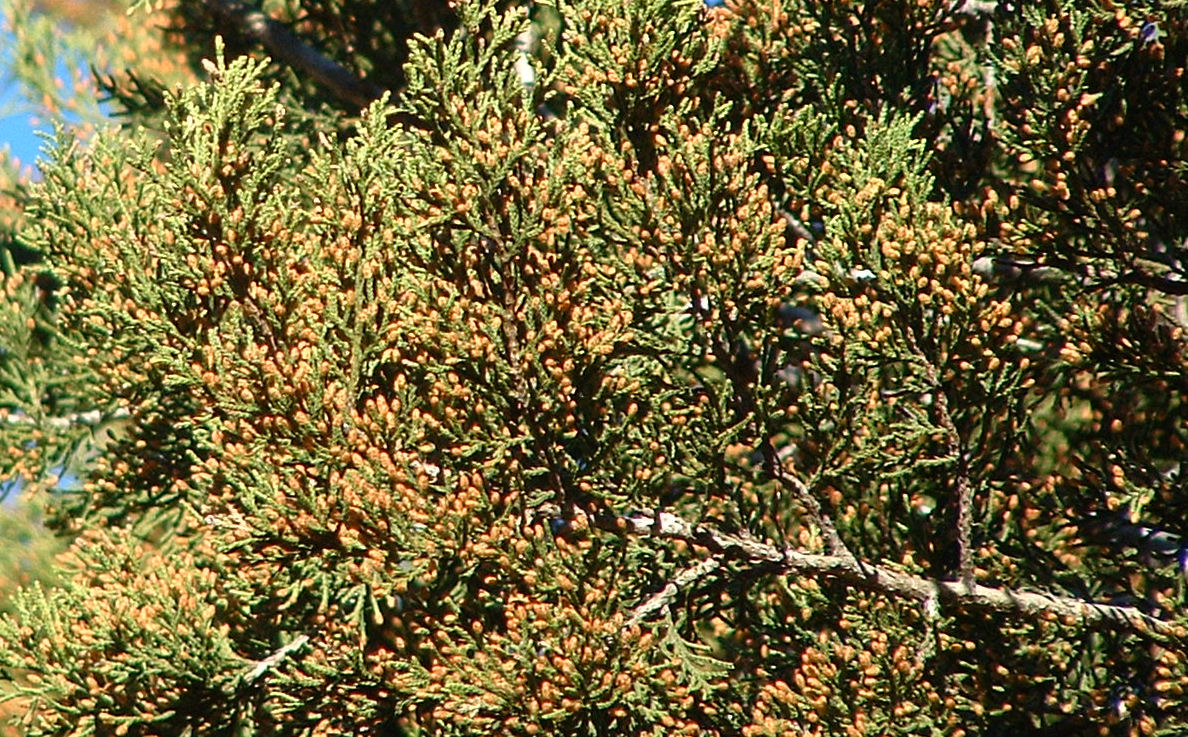
I have a new role model: Steve Nelle, a wildlife biologist with the Natural Resources Conservation Service, an arm of the USDA, in San Angelo. Martin and Madroño Ranch’s redoubtable manager Robert and I went to hear him speak about “Managing Your Hill Country Habitat Effectively” at the spring meeting of the Bandera Canyonlands Alliance in Utopia last week. There was a good turnout of area landowners, ranging from all-thumbs novices like Martin and me to older ranchers whose wide, calloused hands spoke to a lifetime of work with the land.
For those of you with no interest in land management, stick with me; it’s not actually my topic, although Nelle gave an excellent presentation on the role of ash juniper (commonly referred to as cedar) in the Hill Country ecology. Cedar is a species that everybody loves to hate because it’s so remorselessly successful, often at the expense of other species—sort of the Gordon Gekko of Hill Country flora. People here have Opinions about how to manage cedar, ranging from getting rid of most of it to getting rid of all of it.
Nelle spent most of his talk gently lobbing little bombs onto these Opinions, even as his rhetoric defused them. First, he had the authority of thirty-five years of fieldwork, although even as he established his authority, he encouraged us to question it, pointing out that he had spent most of his time in mesquite country, not cedar country. Second, he showed that he knew his audience by noting that one of his principal sources was a local, Eric Lautzenheiser, who has argued that cedar has been unfairly stigmatized; when he brought Lautzenheiser’s name up, Nelle had to pause briefly while several in the audience discussed the exact location of the Lautzenheiser family’s ranch. Third, he was funny. He quoted H. L. Mencken, who said, “For every complex problem, there is an answer that is simple, neat, and wrong,” and when someone asked him how to address a specific issue, he began by saying, “This isn’t the right answer; it’s just what I’d do.” Finally, he acknowledged that there are multiple ways of managing land well; he encouraged each of us to be patient, persistent students of our own land and not to let anyone else tell us what to do with it. He trusted that all of us loved our land and wanted to do the best we could for it. In other words, he expected the best from us.
During the talk I wondered if people might not actually get up and leave, so persistently did Nelle herd up and shoot the sacred cows of cedar control. In fact, as we left, Robert said something like this: Well, hell! He just blew holes in everything I thought I knew! But we agreed that the presentation was ultimately persuasive because of Nelle’s disarming willingness to claim little authority for himself, to link his own experience to someone already known to many in the room, and to respect the experience of everyone present. I’m ready to send him to negotiate between our warring political parties in Washington and Austin.
He was the latest and most welcome example of how people of strongly differing opinions might talk to each other, an undervalued skill these days. The religious historian Karen Armstron recently published a book entitled Twelve Steps to a More Compassionate Life, structured consciously around the twelve-step program pioneered by Alcoholics Anonymous. With it, she hopes to reclaim what she says is the original and most powerful directive of all the world’s great religions, which is to train adherents to become skillful practitioners of the Golden Rule in both its positive and negative formulations: always treat others as you yourself wish to be treated, and do not treat others as you would not like them to treat you. She adds that all these religions “insist that you cannot confine your benevolence to your own group; you must have concern for everybody—even your enemies.”
She lays out a program to help us break our addiction to egotism, which causes us to act with thoughtless violence in both private (our thoughts and relationships) and public (our politics and religion) arenas. “We cannot think how we would manage without our pet hatreds and prejudices that give us such a buzz of righteousness,” she writes; “like addicts, we have come to depend on the instant rush of energy and delight we feel when we display our cleverness by making an unkind remark and the spurt of triumph when we vanquish an annoying colleague.”
To those who would belittle this effort as naïve, she responds that the great religions all arose in response to profound violence:
[T]he sages, prophets, and mystics of these traditions did not regard compassion as an impractical dream. They worked as hard to implement it in the difficult circumstances of their times as we work for a cure to cancer today. They were innovative thinkers, ready to use whatever tools lay at hand in order to reorient the human mind, assuage suffering, and pull their societies back from the brink.
They were warriors of nonviolence, working to break the deeply entrenched cycles of violence directed at self, neighbor, and the world—not a job for the faint of heart.
These are the (wildly simplified) steps she suggests for those who would break their addiction to egotism and violence:
- learn what the world’s religions teach about suffering and compassion;
- look at the expanding rings of your own world and see where suffering is present and compassion is absent;
- develop compassion for yourself, for if you cannot acknowledge your own pain, you will not be able to acknowledge the pain of others;
- use the power of art to develop the muscles of empathy;
- learn to watch yourself mindfully, without judgment, in order to know who you are and to know that you are more than your thoughts about who you are;
- know that every other being has the same desire to be seen and acknowledged that you do, and to act toward others accordingly;
- acknowledge the extremely limited horizon of your knowledge, of yourself, of anyone else, or of any particular situation;
- wonder how you might speak to someone with profoundly differing views from your own, given the fact that you know very little;
- become aware that you cannot restrict your wonderings to people you know, but that you must extend your hope for wellbeing beyond the bounds of your tribe;
- become curious about a people you know nothing about;
- realize the radical commonality between you and those whom you don’t know;
- see that to hate your enemy is to hate yourself, and that to love your enemy is a matter of survival.
I actually don’t like this book very much; it calls me out on lots of behaviors I thoroughly enjoy, like the one that calls us away from trying to defeat opponents verbally and exhorts us to enter empathetically into a rival viewpoint. Armstrong points out that we often identify so strongly with our ideas that we feel physically assaulted when they are questioned, criticized, or corrected. Truth becomes an ancillary issue when we are so enmeshed with our ideas that we can’t imagine another way of thinking, nor enter imaginatively into a perspective that counters our own. Armstrong exhorts us to listen with “the principle of charity,” which requires us to assume that whoever we listen to has as much need to be taken seriously and respectfully as we do.
Well, hell.
While pondering Armstrong’s injunction to respond charitably to my fellow humans, I was reminded of the description of Charles Darwin in Adam Gopnik’s Angels and Ages: A Short Book About Darwin, Lincoln ,and Modern Life. Gopnik wrote that even if Darwin got some of the particulars of evolution wrong—which he did—he got them wrong in the right way, because the spirit of his enquiry into the minutiae of biological operations was filled with the kind of reverent curiosity about all living creatures that Armstrong calls us to show about the human community. Gopnik describes Darwin’s last publication, an unlikely best seller:
The Origin and The Descent of Man are more obviously great books, masterpieces of the human spirit. But if I had to pick up one book to sum up what was great and rich about Charles Darwin, and in Victorian science and the Victorian mind more generally… it might well be On the Formation of Vegetable Mould, through the Action of Worms. Limitless patience for measurement… an ingenuous interest in the world in all its aspects, a desire to order many things in one picture, a faith that the small will reveal the large. And a gift for storytelling: Darwin makes the first person address never feel strange in this scientific text, because we understand that the author is in a personal relation with his subject, probing, testing, sympathizing, playing the bassoon while the earthworms listen and striking the piano while they cower, and trying in every way to see who they are and where they came from and what they’re like—not where they stand in the great chain of being beneath us, but where they belong in the great web of being that surrounds us, and includes us.
Personally, I can imagine playing a bassoon for earthworms more easily than I can imagine entering imaginatively the minds of the many politicians and cultural commentators whose bloviating makes me seethe. But our survival depends on listening carefully and appreciatively to each other. Steve Nelle will make me think about the particular life and condition of each cedar tree we cut down. Perhaps this mindfulness will extend out toward my own species, though I may have to route it through the earthworms first.
What we’re reading
Heather: Amy Stewart, Wicked Bugs: The Louse That Conquered Napoleon’s Army and Other Diabolical Insects
Martin: H. W. Brands, American Colossus: The Triumph of Capitalism, 1865–1900 (still)

Hez, Among you best! I hope it is widely read. Love, Dud